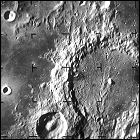 NASA launches the Ranger 9 lunar probe, built by Jet Propulsion Laboratory and intended to go directly to the moon, transmitting pictures of the surface back to Earth until it impacts the lunar surface. Despite NASA scientists’ insistence that the last Ranger probe carry scientific instruments and not just cameras, Ranger 9 is outfitted with cameras only; as a tradeoff, scientists get to nominate its target on the surface, selecting the crater Alphonsus, suspected to be a site of lunar volcanism. Ranger 8 functions flawlessly, sending live video back to Earth until impacting in the crater floor, and for the first time the terminal descent of one of the Ranger probes is broadcast live on TV. This concludes the Ranger program, as NASA now needs to switch its efforts to the unmanned Surveyor lunar landers to find out if the moon’s surface can support the weight of a manned lander. The basic architecture of the Ranger spacecraft is adopted as the heart of the ongoing Mariner planetary space probe series, up to and including the Mariner Jupiter/Saturn ’77 missions (later renamed Voyager) over a decade later.
NASA launches the Ranger 9 lunar probe, built by Jet Propulsion Laboratory and intended to go directly to the moon, transmitting pictures of the surface back to Earth until it impacts the lunar surface. Despite NASA scientists’ insistence that the last Ranger probe carry scientific instruments and not just cameras, Ranger 9 is outfitted with cameras only; as a tradeoff, scientists get to nominate its target on the surface, selecting the crater Alphonsus, suspected to be a site of lunar volcanism. Ranger 8 functions flawlessly, sending live video back to Earth until impacting in the crater floor, and for the first time the terminal descent of one of the Ranger probes is broadcast live on TV. This concludes the Ranger program, as NASA now needs to switch its efforts to the unmanned Surveyor lunar landers to find out if the moon’s surface can support the weight of a manned lander. The basic architecture of the Ranger spacecraft is adopted as the heart of the ongoing Mariner planetary space probe series, up to and including the Mariner Jupiter/Saturn ’77 missions (later renamed Voyager) over a decade later.
Tags:
Categories
Comments are closed